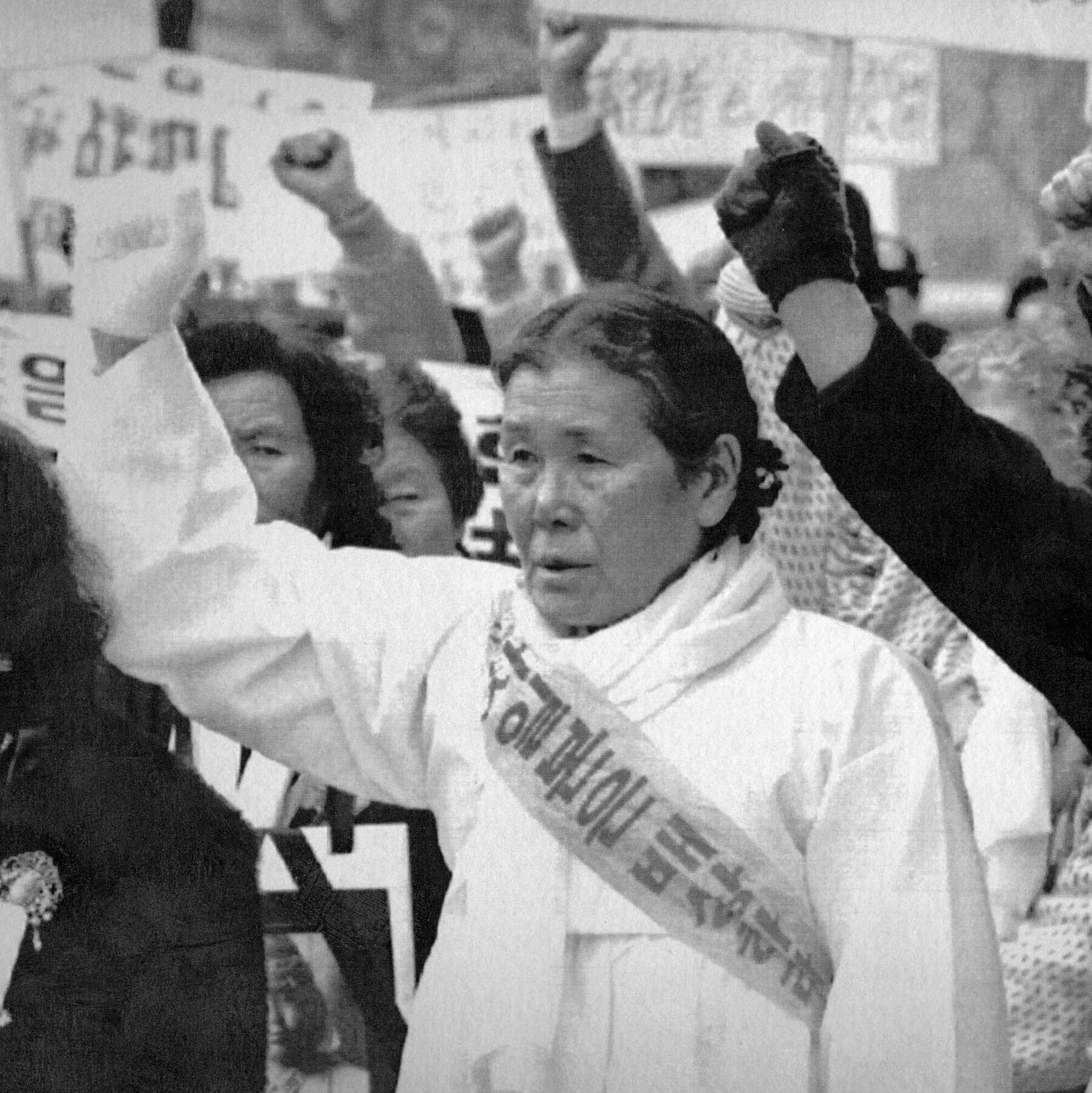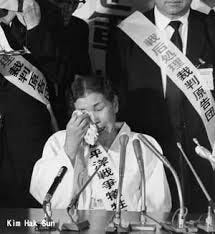Kim Hak Sun and the Story of the Comfort Women
Please note; This story deals with sexual abuse victims and some readers may find this story difficult.
Today I want to introduce to you the story of a Korean woman who became a leading human rights activist, campaigning against sexual slavery and pushing for reparations for victims of wartime sexual violence. After surviving months of captivity and daily assaults, Kim Hak Sun managed to rise up and find her voice, despite the stigma and social isolation associated with women who were victims like her.
Because of her voice, we know what happened to Kim and hundreds of thousands of other women, because of her bravery, other women have been able to find their own voices too.
Kim Hak-Sun was born on October 20, 1924 in Northeastern China. Her Korean parents had emigrated to China during Japan’s colonial rule of Korea. Her father was a Korean Independence Activist who supported the Independence Army, while she didn’t know her father as he died soon after her birth, Kim’s mother returned to Korea with her daughter and when Kim was fourteen, her mother remarried. Not unlike many children whose parents split up and then remarry, Kim rebelled and fought regularly with her stepfather. Things got so tense that Kim was sent to live with a foster family who operated a training school for kiseang. Kiseang were young women who had been outcasts or slaves and were now trained to be courtesans, specializing in the art of conversation and entertainment. They often were employed by the government and while respected for their knowledge and artistic abilities, were still considered to be of low social standing.
When she completed her training and graduated in 1941, her foster father took her and another student to China to help them find employment. Some sources suggest he planned all along to sell the girls into a brothel and other sources say that when they arrived in China, Japanese soldiers detained them. I don’t know which version is true but I prefer to believe he meant well and wasn’t trying to traffick the girls.
The girls were bundled into a military truck and taken to a military unit that Kim later described as attached to a red brick house. That night, Kim was raped by a Japanese officer. Kim and the other girl she had been kidnapped with joined three more girls, of the captives being held there, three were still teenagers.
The captive girls were guarded day and night by the Japanese soldiers who controlled the food that the girls had access to. The soldiers used these girls for sexual gratification whenever they wanted, the girls were at their mercy completely. Every week the girls would be expected to submit to a health check administered by a military physician who checked for venereal diseases. Kim learned quickly that if she fought back, refused sex, or resisted in any way she would be kicked and flogged ruthlessly by the men in charge of her.
Japanese Military Run Comfort Houses
Kim and the others were being held at what is known as a comfort house. The Japanese Imperial Army regularly abducted Chinese, Korean, and Indo-Pacific women to service the needs of its soldiers at its state-run comfort houses. The women in these houses were expected to service as many as 10 men a day and men would line up to see them in their tiny rooms separated by hanging sheets. As Kim would eventually tell South Korea’s KBS-TV in 1992: “They took us as if we were some kind of object, and used us however they wanted. When we broke down with problems like diseases, they abandoned us like objects or killed us.”
Comfort Houses existed from the early 1930s until the end of the Pacific War and historians have estimated that as many as 200,000 women, mostly Korean, were forced into sexual slavery during this time. Comfort Houses are one of history’s largest examples of state-sponsored sexual slavery.
When the soldiers holding Kim and the other women captive were transferred, the women were forced to go with them. Then one day, a Korean man entered the Comfort House and developed a fondness for Kim and, with his help, she managed to escape. She had no home to return to though, and even if she had, the shame of having been a comfort woman would have meant she would live life as a social outcast so she stayed with the man who had helped her escape as he traveled across China delivering opium. Life with this man wasn’t that much better though, despite having two children with him, he was a cruel drunk who would hurl abuse at Kim. He used her history against her and called her vile names, even in front of their children.
In 1945 Japan surrendered and Kim and her family settled in Seoul, but still even more pain was on the horizon for Kim. Both her children died young and then their father was killed fighting in the Korean war. She never remarried, and never had more children. Between the abuses she suffered as a young woman, then at the hands of her partner coupled with the pain and devastation of losing not one but two children, Kim was worn down.
Life After Her Children
By 1987, Kim was barely surviving. She lived in a slum and barely scraped by working odd jobs and collecting government handouts. Her spirit was broken and her heart hurt, at this point in her life, everyone she should have been able to trust and depend on had let her down and her beautiful children were gone. She had nothing left to lose so when in 1991, she heard that the Japanese government was denying that they had run comfort houses she knew it was time to speak up. “I wanted to protest to the Japanese people, ‘You say nothing like that happened, but I survived all that and am living evidence that it did,’” she said in 1991.
She reached out to a women’s rights group and shared her story. At that time, women who had been victims of sexual violence were expected to live in silent shame. Many women died in the comfort houses or died by suicide afterward. Most survivors of the comfort houses worked hard to hide their pasts, so most people had no idea that a monstrous thing such as a state-sponsored rape house had ever existed. Kim dug deep and found the courage she would need to become the first woman to tell the truth about what had happened. At a press conference on August 14, 1991, 67-year-old Kim finally told the world what had happened to her. “It was horrifying when those monstrous soldiers forced themselves upon me,” she said during the news conference, “When I tried to run away, they caught me and dragged me in again.” Images from that event show Kim wiping tears from her face as she recounts the horrors she faced.
By stepping forward, Kim was able to put a human face behind the stories of comfort Houses, her brave testimony inspired 238 other comfort house survivors to eventually come forward to tell their own stories. In 1993 a book of collected testimonies from the victims was published, it was called “The Korean Comfort Women Who Were Coercively Dragged Away for the Military, Vol. 1” Political leaders in Japan had been denying the stories but now, Kim made it harder for them to ignore what had happened.
In 1992, Kim and other survivors wanted to apply pressure on the Japanese government to take legal responsibility for what had happened. They started to protest every Wednesday outside of the Japanese Embassy in Seoul. Every week, they grew stronger and attracted more protestors, and in 1993 Tokyo issued a landmark apology, admitting that the Japanese Military may have been directly or indirectly involved in the management of comfort houses and that women had been coaxed or coerced into participation.
In 1998, a United Nations rapporteur called Gay J. McDougall published a report defining the actions of the Japanese Army’s enslavement of women as crimes against humanity. In more recent years, McDougall has said of Kim: “Nothing that I wrote could come close to the impact of the personal firsthand account given publicly by Kim Hak-Sun 30 years ago,”
Until the day she died, Kim continued to demand that the Japanese Government formally apologize to their victims and offer financial restitution. To this day, this demand has been refused by the Japanese government. Many conservatives in Japan continue to deny that comfort women were anything other than voluntary prostitutes, despite hundreds of testimonies and evidence proving otherwise.
In an interview with an online newspaper Kim explained “I wanted to speak out before I died because no one else would on my behalf,” she said. “I have no desire left other than to hear them say they are truly sorry.”
In recent years news articles and historical documents have been discovered all over Korea, Japan, and China that point clearly to the Japanese army’s involvement in the establishment and operation of frontline brothels. In Korea, school textbooks have been updated to reflect the truth of the history of comfort houses.
Kim’s Legacy
Kim died of lung disease in 1997, and while she didn't live long enough to get her apology, her legacy lives on and her courage has inspired countless other victims to come forward. In 2018 South Korea began to celebrate annually the anniversary of Kim’s testimony on Aug 14. The day is a national day of remembrance and mourning for the former comfort women.
The Wednesday demonstrations continue every week outside the Japanese embassy in Seoul. Organized by The Korean Council for the Women Drafted for Military Sexual Slavery by Japan, the objectives for the continued protests are "the restoration of dignity and human rights of comfort women." According to the Korean Council, the "Wednesday Demonstrations have turned into a place for solidarity between citizens and the victims, a living site for history education, a platform for peace and women's human rights, bringing people together in solidarity beyond gender, age, borders, and ideologies." The Korean Council insists that they will continue protesting until Korea has considered the rights and dignity fully restored to the victims. Specifically, the group is asking for the war crimes to be resolved with the following measures:
Acknowledge the war crime.
Reveal the truth in its entirety about the crimes of military sexual slavery.
Make an official apology by the Japanese Government.
Make legal reparations.
Punish those responsible for the war crime.
Accurately record the crime in history textbooks.
Erect a memorial for the victims of military sexual slavery and establish a historical museum.
While Japan has created a fund called the Asian Women’s Fund valued at over 5.5 million dollars that is meant to provide support and health care to survivors, the Korean victims have refused to accept it. They say that to accept private money is to allow Japan to take only moral responsibility. Tokyo has argued that Japan’s legal responsibility was already accounted for through the 1951 San Francisco Peace Treaty with Allied Powers.
The Wednesday Demonstration is the world’s longest-running protest anywhere in the world and each week it renews its record. Elderly original activists are joined by younger generations of people who demand that Japan offer a sincere apology. To honour the 1000th rally, held on December 14, 2011, the Statue of Peace was erected. It depicts a young Korean girl, representing the hundreds of thousands of young victims, she is sitting and facing the site of the Japanese Embassy. On her shoulder sits a bird, symbolic of peace and freedom. Today several recreations of this statue stand all over the world, a silent testament to the horrors that the comfort house victims endured.






